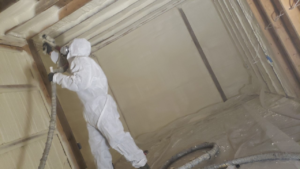To understand how insulation works inside your home we first need to look at how heat moves inside your home. Heat moves in three ways; radiant, conductive, and convectional heat loss and gain.
- Radiant heat loss and gain is similar to standing in front of your stove top and turning on the burners. You'll feel the heat radiating on the front of your body but not on your backside.
- Conductive heat loss and gain is a transfer through contact. A pot sitting on the stove top is in contact with the burner that's on. Once you add food it's in contact with the pot, so it cooks the food.
- Your home however, is more like an oven which is convectional. Inside an oven you heat the air and the hot air is what cooks the food. The same thing applies to the inside of your home. In the winter we heat the air, that's what keeps us warm and comfortable. In the summertime we condition the air in order to keep us cool and comfortable.
It's also important to note that heat moves from more to less and pressure also moves from more to less.

Why Home Insulation Effects Your Comfort
In the winter time when your heating the air inside of your home, the hot air becomes buoyant. This means that the air rises to the top of your home. Air moving to the top of your house, builds a positive pressure, looking for ways to leak to the outside. This conditioned air that you paid for, will be gone forever. The one thing that always remains the same inside your home is the overall volume of air. For every unit of air that we lose we have to take a new unit of air from somewhere else. Normally you will take that air in from the walls, rim joist or crawl spaces.
This happens because when you build a positive pressure up top you have to build a negative pressure down low. You are literally sucking in the outside air to replace what you're losing or blowing out through the top. This causes you to have to recondition the air in your house. The faster that the cycle moves, the more expensive it is and the less comfortable your home is. So to properly insulate your home will create that buffer from the outside world to the inside of your home. The true trick to energy efficiency and comfort in your home is keeping the conditioned air in. The less air changes per hour the more comfortable and energy-efficient your home will be.
Types Of Insulation
The most common type of insulation in any home is fiberglass. While Fiberglass is effective for radiant and conductive heat loss and gain, it does nothing for the air driving home. If you think about your furnace filter it's made of fiberglass and that's because fiberglass is great at filter. However, the fiberglass will not stop the air movement. This is why almost every home that has fiberglass insulation ends up having high energy bills. Again the more air that leaks out, the more units of air you have to pay to condition.
Cellulose is reground paper and recycled plastic products. Cellulose has a tendency to settle which makes it good in some applications bad in others. For instance blow in cellulose in an attic is great because it naturally settles. This creates a better air barrier. However, trying to Dense pack it in an enclosed wall cavity rarely works. Most dense pack jobs will settle 30 to 50% within 3 to 5 years. Also since cellulose is biodegradable it has a tendency to settle more and faster.
Then there are several foam insulation's and applications for a home. The differences between types of foam refer to density and way it's applied. Let's break down the density first and then we can break down to the application.

The differences With Foam Insulation
Open cell and Closed cell foam refer to the density and weight of the material. For instance open cell foam weighs a half pound per cubic foot. Close cell foam weighs 2 pounds per cubic foot. The difference in the density is what defines the R-value air sealing capabilities and vapor permeability. Open cell R-value is 2.5 to 3.5 per inch. Close cell R-value is 5.1 to 7.5 per inch. When we talk about R value we are referring to the resistance of heat transfer. The higher the number, the longer it takes for the heat to transfer through the product. Also density makes a difference.
Open cell foam allows vapors to pass through it and get trapped in it. If the air can still move through it you are not stopping convectional heat loss and gain. You would however, achieve this with close cell spray foam. With close cell spray foam you get an air seal at 1.5 inches and vapor barrier at 2 inches. This means air and vapors cannot pass through it.
Applications Of Foam Insulation In Your Home
There are two different types of foam applications you have spray foam and injection from.
- Spray foam is used for open wall cavities from the inside of your home. This works for hot decking roofs, or knee walls in Bungalows and Cape Cod style homes.

- Injection foam is installed into enclosed wall cavities that are no deeper than 6 inches.

Knowing how home insulation works may seem overwhelming after this. But there's good news! There are professional companies like USA Insulation that can help you. You do receive a free in home insulation analysis, and you also gain free knowledge. Call today!



